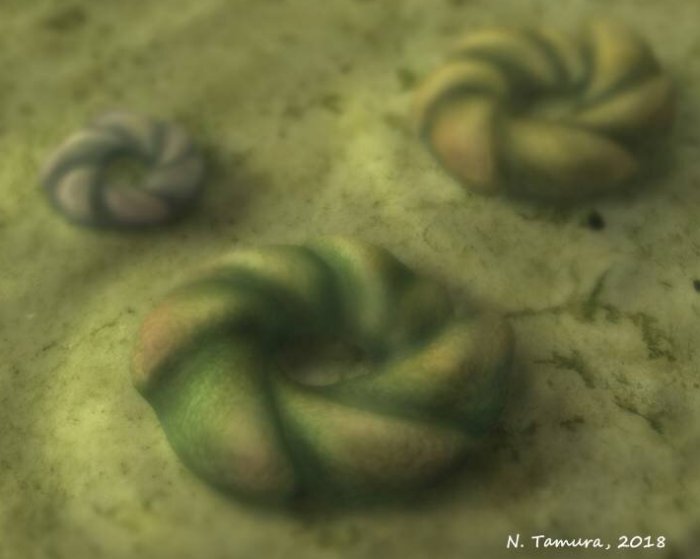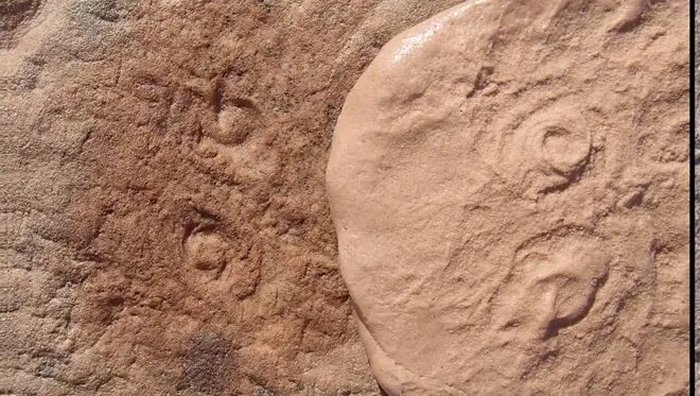Conny Waters – AncientPages.com – Even without body parts that allowed for movement, new research shows—for the first time—that some of Earth’s earliest animals managed to be picky about where they lived.

Life restoration of Obamus coronatus, a tiny, toroidally shaped, soft-bodied animal from the Ediacaran biota of South Australia. Credit: Nobu Tamura
These creatures from the Ediacaran Period, roughly 550 million years ago, are strangely shaped soft-bodied animals that lived in the sea. Researchers have long considered them enigmatic.
“It’s not like studying dinosaurs, which are related to birds that we can observe today,” said Phillip C. Boan, UC Riverside paleontology graduate student and lead author of the new study. “With these animals, because they have no modern descendants, we’re still working out basic questions about how they lived, such as how they reproduced and what they ate.”
For this particular research project, the researchers focused on understanding where in the sea the animals spent their lives.
The ancient sea was also a largely foreign place compared to today’s marine environments. It was dominated by a mat on the sea floor composed of bacteria and layers of other organic materials. In addition, predatory creatures were uncommon.
Given the alien nature of Ediacaran Earth, the researchers were surprised to find an animal that lived much the way barnacles do today. A new Paleobiology paper details how Obamus coronatus, named for the former U.S. president, opted to live on specific parts of the sea floor in the company of other Obamus.
The animal averaged about a half-inch in diameter and was “shaped like a French cruller donut with ribbons on top,” Boan said. It did not move of its own accord, and likely spent its entire life embedded in its preferred spot on the sea floor.

Obamus fossils embedded in sandstone. Credit: Mary Droser/UC Riverside
“We think about the very oldest animals and maybe you wouldn’t expect them to be so picky. But Obamus only occurs where there is a thick mat, and it’s a pretty sophisticated way of making a living for something so very old,” said Mary Droser, UCR distinguished professor of paleontology and study co-author.
In 2018, Droser’s laboratory named the Obamus in honor of Barack Obama’s pᴀssion for science. Her group discovered it at an extraordinarily well-preserved fossil site in the Australian Outback, at what is now called Nilpena Ediacara National Park.
A series of storms buried the Ediacaran sea floor at Nilpena in layers of sediment, helping preserve sandstone impressions of entire animal communities that lived together there. “This way, we’re able to piece together whole ecosystems,” Droser said. “Looking at them is like snorkeling around on the ancient sea floor, instead of looking at a single animal in a fish tank.”
For this project, the research team selected three animals found in relatively large numbers at Nilpena, and examined how they were geographically distributed.
The other two animals, Tribrachidium and Rugoconites, are also immobile creatures with no modern descendants. “They are tri-radially symmetrical, like the Mercedes Benz logo,” Boan said. “And they would have lived their entire lives embedded in the sea floor, as Obamus did.”
Distribution for these other two animals was varied. Sometimes they could be found living in the company of other organisms like themselves, but not in every instance. However, Obamus displayed a clear preference.
“This is really the first example of a habitat-selective Ediacaran creature, the first example of a macroscopic animal doing this,” Boan said. “But how did they get where they wanted to go? This is a question we don’t yet know the answer to.”
The research team theorizes that Obamus were likely motivated by the need to reproduce.
“There are a limited number of reproductive strategies, especially for animals like these,” Droser said. “There are more strategies today, and they’re more elaborate now. But the same ones used today were still being used 550 million years ago.”
Obamus likely spread itself via selective larva that preferred locations with thick microbial mat and near other Obamus. “We don’t entirely understand how Obamus offspring spread out, but we know that when they picked a place to live, it was very specific,” Boan said.
A deeper understanding of how life on Earth developed over time can give researchers insight into how life could develop on another planet. For this reason, Droser’s lab is funded by NASA’s Exobiology program.
“This is our window into how a complex ecosystem forms,” Boan said. “We only have Earth, and we need to use every part of its history when thinking about life, even way off in the cosmos.”
Paper
Written by Conny Waters – AncientPages.com Staff Writer





